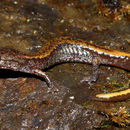Description
provided by AmphibiaWeb articles
A small terrestrial salamander. The sides are dark brown to black with white flecks, and a mid-dorsal stripe varies from red to chestnut. Black pigment in the dorsal stripe may be small spots or chevrons (^). The stripe runs from the head to the tip of the tail. The venter is salmon-pink or reddish with black specks. The outer toe of the hind foot is small. Adults reach sizes of 35-55 mm snout to vent length (75-100 mm total lengh). Females reach larger adult sizes than males (50 vs. 45 mm SVL). Modal number of costal grooves is 15. Males lack mental glands. Hatchlings are 17-18 mm SVL (Brodie 1970; Leonard et al. 1993; Petranka 1998).Plethodon larselli may be distinguished from other Pacific Northwest species of Plethodon by the reddish coloration of the venter, the dorsal stripe which extends to the tail tip, and the small size of the outer toe on the hind feet (Stebbins 1985; Leonard et al. 1993).
Herrington, R. E., and Larsen, J. H., Jr. (1987). ''Reproductive biology of the Larch Mountain Salamander (Plethodon larselli).'' Journal of Herpetology, 21(1), 48-56.
- author
- Meredith J. Mahoney
Distribution and Habitat
provided by AmphibiaWeb articles
A restricted range in the Columbia River gorge of Oregon and Washington, and north in the Cascade Mountains to the vicinity of Mt. St. Helens, Washington.Salamanders inhabit mesic talus slopes, and other rocky areas. Animals are frequently found among talus and gravel. Most populations are found in humid mixed forests of Douglas Fir and hardwoods (Leonard et al. 1993; Petranka 1998).
- author
- Meredith J. Mahoney
Life History, Abundance, Activity, and Special Behaviors
provided by AmphibiaWeb articles
Like other members of the genus Plethodon, P. larselli is completely terrestrial through all stages of its life history; courtship, mating, and egg deposition occur on land. There is no free living larval stage, and juveniles hatch completely metamorphosed (Stebbins 1985; Petranka 1998).Courtship behavior has not been described, but general facts are known based on closely related species. Fertilization occurs by means of a spermatophore deposited on the substrate by the male and picked up in the cloaca by the female (Duellman and Trueb 1986). Mating occurs during fall and spring months (Nussbaum et al. 1983; Herrington and Larsen 1987). Females may only breed every 2-3 years (Herrington and Larsen 1987). Nests have not been found, but females likely lay underground within talus, and tend the eggs until hatching in late summer or early autumn (Petranka 1998). Average clutch size is about 7 (Nussbaum et al. 1983; Herrington and Larsen 1987).Diet is varied, including mites, collembolans, snails, annelids, spiders, beetles, and hymenopterans (Altig and Brodie 1971; Nussbaum et al. 1983). Likely predators of P. larselli include small snakes, birds, and small mammals. When molested, individuals rapidly coil and uncoil. This behavior may move them rapidly away from potential predators (Nussbaum et al. 1983; Petranka 1998).
- author
- Meredith J. Mahoney
Life History, Abundance, Activity, and Special Behaviors
provided by AmphibiaWeb articles
The talus slope habitat of many populations is extremely fragile (Leonard et al. 1993). Populations are also threatened by logging, and road building (which uses talus) (Petranka 1998).
- author
- Meredith J. Mahoney
Larch Mountain salamander: Brief Summary
provided by wikipedia EN
The Larch Mountain salamander (Plethodon larselli) is a species of salamander in the family Plethodontidae endemic to the United States. It occurs in the Cascade Mountains of southern Washington and northern Oregon. In Washington, it occurs from the Columbia River Gorge to just north of Snoqualmie Pass. Its natural habitats are temperate forests and rocky areas. It is threatened by habitat loss.
- license
- cc-by-sa-3.0
- copyright
- Wikipedia authors and editors

